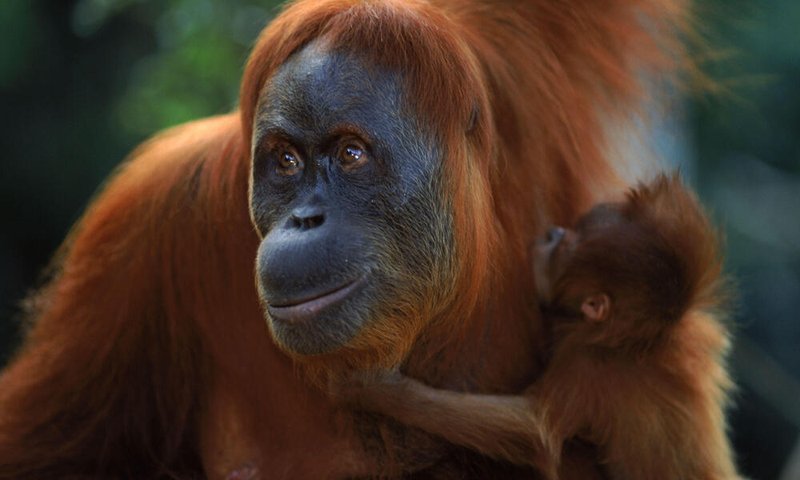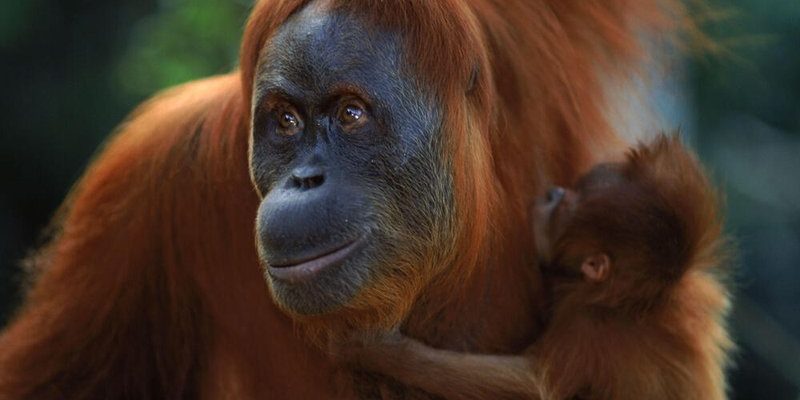
Sumatran orangutans thrive in the tropical rainforests of Sumatra, Indonesia. These forests are teeming with life and serve as the perfect backdrop for the orangutans to live, feed, and play. Unfortunately, their habitat is shrinking, and understanding where they live is crucial to their survival. So, let’s dig a little deeper into their habitat and distribution.
The Heart of Their Home: Sumatran Forests
Sumatran orangutans primarily inhabit the dense tropical rainforests of Sumatra. These forests are full of towering trees, vines, and a rich variety of plants. Imagine walking through a place where sunlight barely touches the forest floor because the canopy is so thick. That’s the environment that makes these orangutans feel right at home.
The trees in these forests are not just for climbing; they also provide vital food sources. Orangutans primarily eat fruits like durian, rambutans, and figs. They spend most of their lives in the trees, munching away and swinging from branch to branch. This high-up lifestyle protects them from predators and allows them to reach their food with ease. Here’s the thing: their habitat plays a crucial role in keeping the entire ecosystem healthy.
However, these rainforests are not just ordinary forests; they are unique ecosystems filled with fascinating creatures and plants. The Sumatran rainforests are considered one of the world’s biodiversity hotspots, meaning they house a large number of unique species. It’s like a treasure chest of life, and orangutans are a key part of it.
Where Else Can You Find Them? Distribution Across Sumatra
While Sumatran orangutans mainly live in the rainforests of Sumatra, their distribution isn’t as wide as you’d think. They are primarily found in three key areas: the northwestern regions of Sumatra, such as Gunung Leuser National Park, the central part of the island around Bukit Barisan Selatan National Park, and the southern tip of Sumatra in the Way Kambas National Park.
These regions provide the ideal mix of food, shelter, and safety for orangutans. However, it’s essential to note that their territories can vary based on food availability. If food is abundant in one area, they might roam farther to find the best fruits and leaves. This flexibility is crucial for their survival.
Honestly, the fact that they are so limited in distribution raises some serious concerns. As their habitats shrink due to deforestation and human activities, the areas where they can thrive are getting smaller and smaller. This can create isolated groups of orangutans, which makes it harder for them to maintain a healthy population.
The Impact of Deforestation on Their Habitat
One of the biggest threats to Sumatran orangutans is deforestation. Imagine a lush, green landscape being turned into barren fields for palm oil plantations. This kind of habitat loss doesn’t just affect the orangutans; it also impacts countless other species that share their home.
Deforestation occurs for various reasons, including agriculture, logging, and urban development. When these activities take place, the large trees that provide food and shelter for orangutans are cut down, leading to habitat fragmentation. With their homes disappearing, orangutans find it increasingly challenging to find food and mates.
Moreover, isolated orangutan populations are at a higher risk of extinction. If they can’t interact with one another, they might struggle to find genetic diversity, which is vital for long-term survival. This can lead to inbreeding, which weakens the species over time.
Conservation Efforts: Protecting Their Home
Fortunately, there are many conservation efforts in place aimed at protecting Sumatran orangutans and their habitats. Various organizations are actively working to preserve their rainforest homes. This includes establishing protected areas, creating wildlife corridors, and promoting sustainable practices among local communities.
For instance, the creation of national parks like Gunung Leuser and Bukit Barisan Selatan plays a significant role in conserving orangutan habitats. These parks help safeguard the rich ecosystems that support not only orangutans but also other endangered species. By preserving these areas, we help maintain the delicate balance of nature.
In addition to protected areas, education and awareness campaigns are crucial. Teaching local communities about the importance of orangutans and their habitats can lead to better conservation practices. When people understand why these creatures matter, they’re more likely to protect them.
What You Can Do to Help
You might be wondering, “What can I do to help Sumatran orangutans?” There are plenty of small steps you can take that can make a big difference. Supporting organizations dedicated to orangutan conservation is a great start. Many of these groups work on the ground to protect natural habitats and rehabilitate orphaned or displaced orangutans.
Another way to contribute is by being mindful of the products you consume. Choose sustainable palm oil products when you shop. Palm oil is in many everyday items, from snacks to cosmetics. By opting for sustainable options, you support practices that protect the habitats of orangutans and other wildlife.
Lastly, spreading the word about Sumatran orangutans and their plight can raise awareness. Share what you learn with friends, family, or on social media. The more people know, the more they can help!
Final Thoughts: A Call to Action
Sumatran orangutans are incredible creatures that play a key role in their rainforest ecosystems. Their habitat is as mesmerizing as it is crucial to their survival. Understanding where they live and the challenges they face helps us appreciate their plight and take action to protect them.
With deforestation threatening their homes, it’s up to all of us to support conservation efforts and make informed choices. Remember, every action counts, no matter how small. Together, we can help ensure that future generations will be able to witness the beauty of Sumatran orangutans swinging gracefully through their trees.

